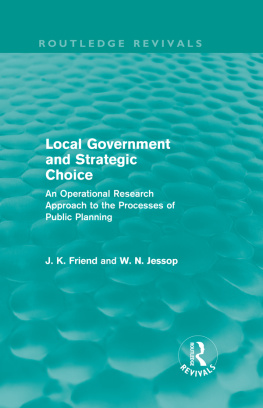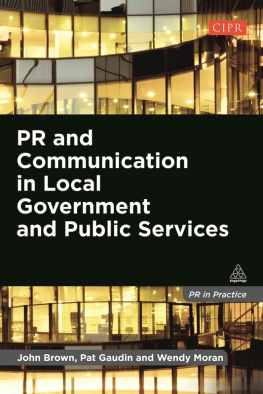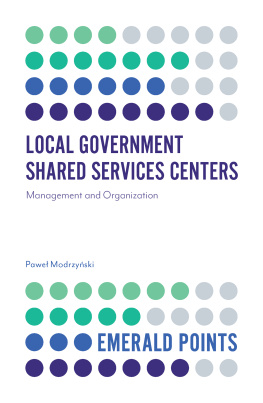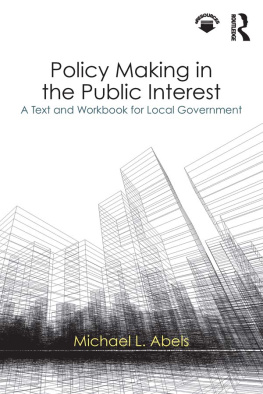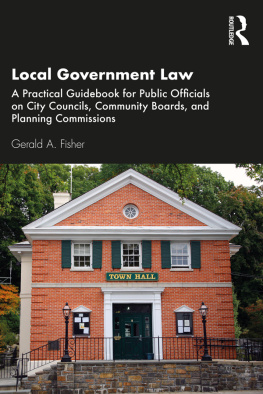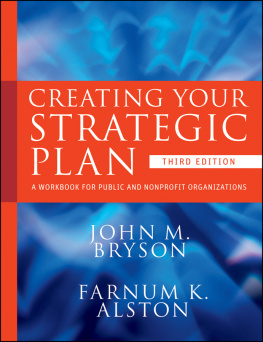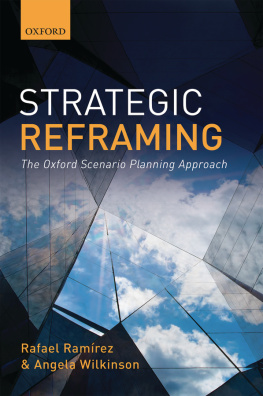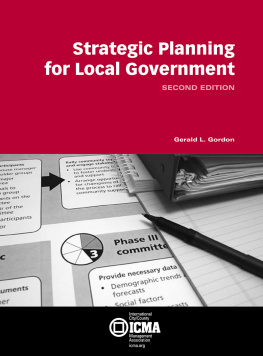Routledge Revivals
Local Government and Strategic Choice
First published in 1969, this book is concerned with the processes of policymaking in local government. The authors address themselves to the basic challenge of planning in a democracy and consider issues such as how those elected to exercise choice on our behalf can preserve and expand their capacity to choose discriminatingly, when the sheer complexity of the issues facing them tends all the time to make them increasingly dependent on the skills and judgements of their professional advisers. This question is explored in relation to the many different, yet interdependent, aspects of the planning process which impinge on any local community with particular reference to the planning of housing, transport, education, and shopping, of land use and local government finance.
The book is the outcome of a four-year program of research during which a mixed team of operational research and social scientists was given a unique opportunity to observe the ways in which decisions were made and plans formulated in one particular city- Coventry. It covers both political and professional aspects of local government in 1960s Great Britain and has had important implications for urban governments throughout the world.
Local Government and Strategic Choice
An Operational Research Approach to the Processes of Public Planning
J. K. Friend and W. N. Jessop
First published in 1969
by Tavistock Publications Ltd
This edition first published in 2013 by Routledge
2 Park Square, Milton Park, Abingdon, Oxon, OX14 4RN
Simultaneously published in the USA and Canada
by Routledge
711 Third Avenue, New York, NY 10017
Routledge is an imprint of the Taylor & Francis Group, an informa business
1969 Tavistock Institute of Human Relations
All rights reserved. No part of this book may be reprinted or reproduced or utilised in any form or by any electronic, mechanical, or other means, now known or hereafter invented, including photocopying and recording, or in any information storage or retrieval system, without permission in writing from the publishers.
Publishers Note
The publisher has gone to great lengths to ensure the quality of this reprint but points out that some imperfections in the original copies may be apparent.
Disclaimer
The publisher has made every effort to trace copyright holders and welcomes correspondence from those they have been unable to contact.
A Library of Congress record exists under ISBN: 70409702
ISBN 13: 978-0-415-65898-0 (hbk)
ISBN 13: 978-0-203-07539-5 (ebk)
LOCAL GOVERNMENT AND STRATEGIC CHOICE
SECOND EDITION
An Operational Research Approach to the Processes of Public Planning
J.K. FRIEND
and
W.N.JESSOP
Copyright 1969 Tavistock Institute of Human Relations
First edition published in 1969 by
Tavistock Publications Ltd.
Second impression 1971 SBN 422 73050 5
First published as a Social Science Paperback
in 1971 SBN 422 75290 8
Copyright 1977 Pergamon Press Ltd.
Second edition 1977
Reprinted 1978
All Rights Reserved. No part of this publication may be reproduced, stored in a retrieval system or transmitted in any form or by any means: electronic, electrostatic, magnetic tape, mechanical, photocopying, recording or otherwise, without permission in writing from the publishers
This book was written under the auspices of the Institute for Operational Research, 56-60 Hallam Street, London W. 1, and 42B New Union Street, Coventry, Warwickshire
Maps 1-6 and Figure 8 are reproduced by courtesy of Coventry City Council. All other maps and diagrams were drawn by S. Wyatt
Library of Congress Cataloging in Publication Data
Friend, John Kimball.
Local government and strategic choice, 2nd Edition
Bibliography: p.
Includes index
1. Local governmentGreat Britain. 2. Cities and townsPlanningGreat Britain. I. Jessop, William Neil, joint author.
JS3111.F74 1976 352.960941 76-26658
ISBN 0-08-021176-3 (Hard cover)
ISBN 0-08-021451-7 (Flexicover)
Urban and Regional Planning Series
Volume 14
Printed in Great Britain by A. Wheatson & Co. Ltd, Exeter
Contents
Maps
This edition of Local Government and Strategic Choice goes to print seven years after completion of the original manuscript: seven years in which many events have occurred to justify some additional words of introduction, over and above those which follow on the next few pages.
First, this edition gives me the opportunity to acknowledge my lasting debt to my co-author and former colleague, Neil Jessop, first Director of The Institute for Operational Research. His sudden and untimely death, even though preceded by a period of recurrent illness, followed only a matter of days after the publication of the original edition of this book in April 1969. There are many ways in which those of us who worked with Neil Jessop have missed his presence since; not least, in my case, I have missed the opportunity to share with him any discussion of the various reactions which the publication of our study has since stimulated among planners, administrators, management scientists and political analysts in Britain and elsewhere.
As we worked on the manuscript, Neil and I shared a sense of apprehension about the way in which the more speculative of the ideas we wished to present might be received. For me, the various opportunities which have since arisen to test, apply and develop our view of planning as a process of strategic choice have been both exciting and exacting. I have not sought to change the main text in any way to reflect these subsequent events; instead, 1 have added a short postscript, with supplementary bibliography, to describe some of the main currents of subsequent work which have been influenced in one way or another by the basic ideas presented here.
In this Foreword, it is fitting that I should do no more than to comment briefly on the four main parts of the book in turn, seeking to reassess the continuing relevance of each in the light of subsequent events. In , has provided a foundation for much subsequent work in urban planning and related fields.
The schematic diagrams around which the comparatively brief second section of the book is built, presenting our view of planning as a process of strategic choice, have over the last seven years been elaborated, modified and rearranged in a variety of ways for a variety of purposes, without altering the underlying ideas in any fundamental way. Among subsequent developments at this general level, particular attention has been given to the articulation of some further ideas about interorganisational planning processes, as opposed to what is now usually known as the corporate level of planning. The evolution of this particular stream of work is outlined a little more fully in the Postscript.
The third part of the book, using fictional case study material to develop ideas about a technology of strategic choice intended to relate to the uncertainties and political realities of urban decision-making, was largely speculative when first written. Now, however, some substantial experience has accumulated in applying this analytical approach to a variety of urban and regional planning problems: again, the course of this further line of development is charted more fully in the postscript. In practice, the approach has usually had to be adapted freely to the varied situations encountered, very much as suggested in the series of case studies here presented. A further book giving a brief working guide to the techniques concerned, and to the skills of applying them in differing problem situations, is now in preparation within the present Pergamon series.


